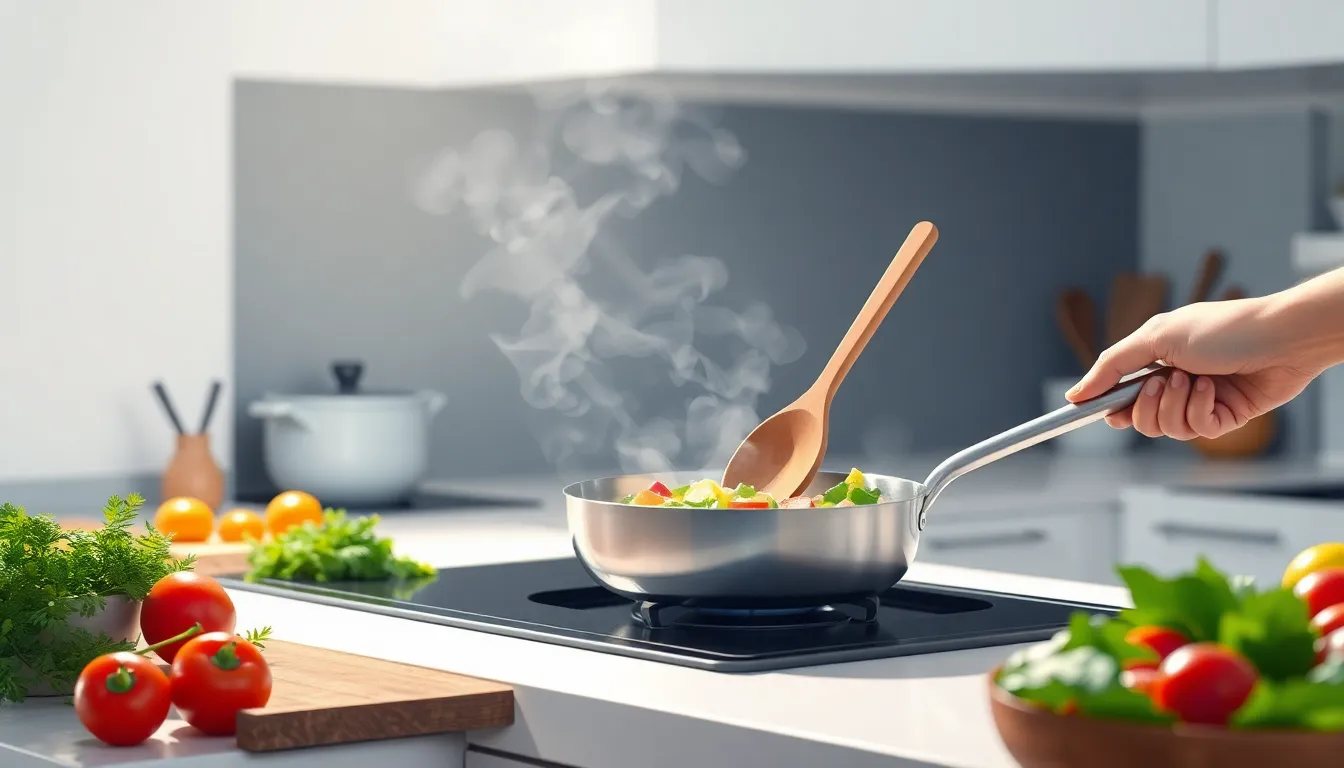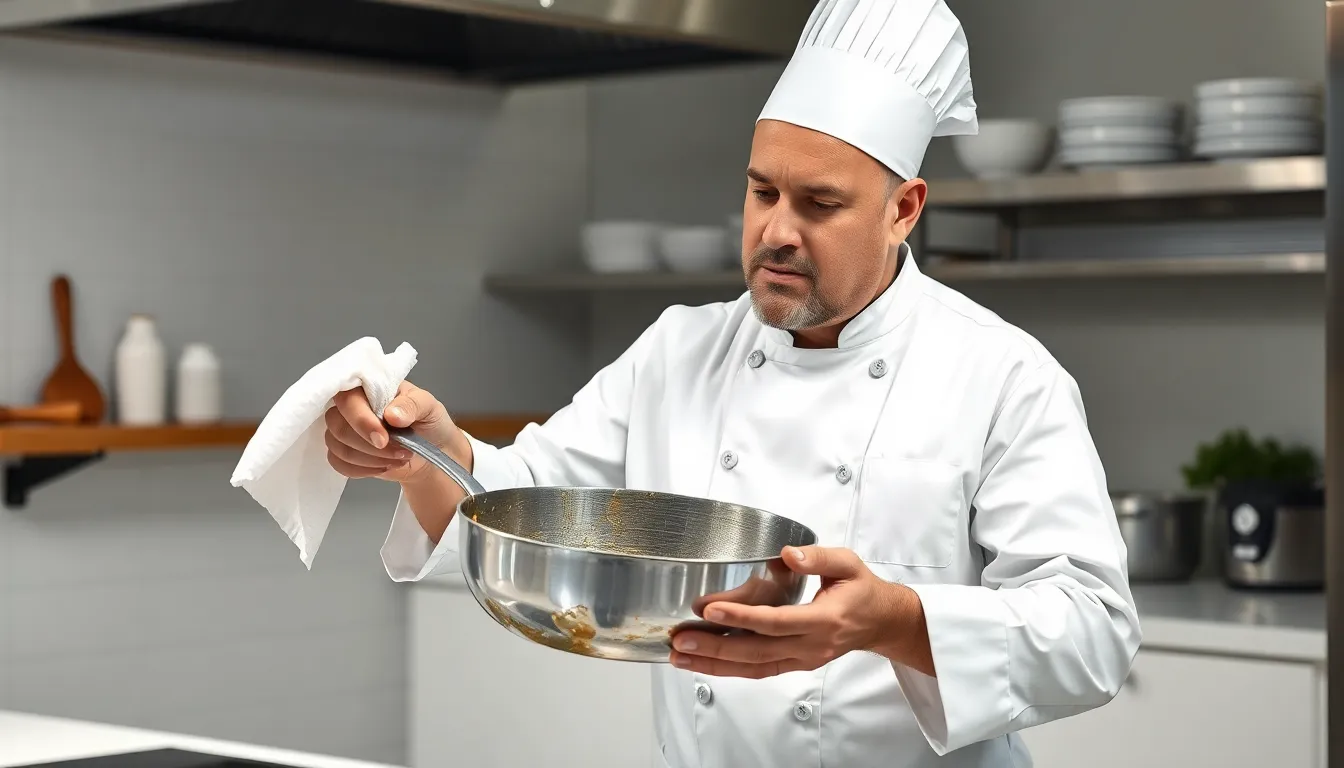Physical Address
304 North Cardinal St.
Dorchester Center, MA 02124
Physical Address
304 North Cardinal St.
Dorchester Center, MA 02124

Stainless steel cookware can feel like a culinary enigma wrapped in a shiny exterior. Many home cooks love its sleek look but dread the thought of sticking food and stubborn stains. Fear not! With a few simple tips, anyone can master the art of cooking with stainless steel and turn their kitchen into a five-star restaurant—minus the overpriced entrees and the need for a reservation.
Stainless steel cookware offers numerous advantages that enhance cooking and kitchen efficiency. This material attracts many home cooks due to its impressive features.
Stainless steel cookware exhibits exceptional durability, resistant to scratches and dents. Many cooking enthusiasts appreciate that this resilience means less frequent replacement, resulting in cost savings. High-quality stainless steel withstands high temperatures, ensuring it remains functional over time. Additionally, it doesn’t chip or bend easily, making it ideal for busy kitchens. It’s essential to choose heavy-gauge options for optimal performance. With proper care, stainless steel cookware can last for decades, retaining both appearance and functionality.
Cooking with stainless steel offers a non-reactive surface, making it safe for a variety of ingredients. Acidic foods like tomatoes and citrus won’t interact negatively with the cookware, preserving flavors and nutrients. This property enables versatility, allowing cooks to prepare diverse recipes without worrying about chemical reactions. Cleaning becomes effortless since food residue does not bond with the surface. It’s crucial to maintain a clean surface to maximize performance. Using stainless steel promotes healthier cooking methods and ensures delicious results.

Preparing stainless steel cookware enhances its performance and longevity. Following these simple steps ensures effective use and minimizes issues like sticking.
Seasoning stainless steel creates a natural non-stick layer. Start by heating the pan over medium heat until hot. Add a thin layer of oil, like vegetable or canola, allowing it to heat until shimmering. Next, use a paper towel to spread the oil evenly across the surface. Allow it to cool and wipe off excess oil. Repeating this process a few times builds a durable seasoning, improving food release.
Cleaning stainless steel cookware before first use removes manufacturing residues. First, wash the pots and pans in warm, soapy water. Use a soft sponge or cloth to avoid scratching the surface. Rinse thoroughly with hot water, ensuring no soap remains. Dry the cookware completely with a clean towel. Proper cleaning sets the stage for optimal cooking performance, ensuring safety and flavor.
Stainless steel cookware offers unique techniques that enhance cooking efficiency and food quality. Proper use significantly elevates culinary experiences.
Preheating a stainless steel pan is crucial for optimal cooking. Begin by placing the pan on medium heat for about 2-3 minutes. Testing the heat can be accomplished using the water drop method: add a few drops of water and observe if they dance across the surface. A well-preheated pan ensures that food browns evenly and reduces sticking. Seasoning the pan with a thin layer of oil after preheating improves non-stick properties and enhances flavors.
Maintaining appropriate heat levels is essential when cooking with stainless steel. Start with medium heat for delicate items like eggs or fish to avoid sticking. Increase the heat for searing meats, which requires high temperatures for a perfect crust. Adjusting the heat promptly during cooking is vital; overheating can burn food, while too low may lead to uneven results. Stainless steel’s excellent heat conductivity allows quick adjustments, ensuring precise temperature control throughout the cooking process.
Proper maintenance and care extend the lifespan of stainless steel cookware while preserving its performance and appearance. Adhering to specific guidelines simplifies the upkeep process.
Utilize warm soapy water and a soft sponge for routine cleaning. This approach effectively removes food residue without scratching the surface. For stubborn stains, create a paste from baking soda and water, then gently scrub the affected area. Vinegar offers an alternative solution for cleaning, as its acidity helps dissolve mineral deposits. Ensure cookware dries completely to prevent water spots.
Opt for wooden or silicone utensils when cooking, as these materials reduce the risk of scratching the surface. Store cookware properly by stacking or hanging it without direct contact with other metal items. Consider using protective liners or cloths between stacked pieces. Avoid dropping cookware or exposing it to extreme temperature changes, as these actions can lead to dents. Regular inspection for any signs of damage helps maintain the cookware’s integrity.
Stainless steel cookware can transform any kitchen experience when used correctly. By following the tips shared in the article, cooks can enhance both the performance and longevity of their cookware. This durable material not only offers a sleek appearance but also provides versatility for various cooking methods.
Proper care and maintenance will ensure that stainless steel remains a staple in the kitchen for years to come. Embracing these techniques allows for delicious meals while enjoying the benefits of this exceptional cookware. With a bit of practice and attention, anyone can master the art of cooking with stainless steel.